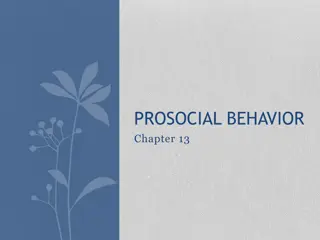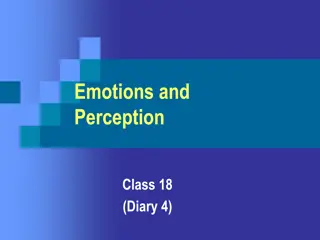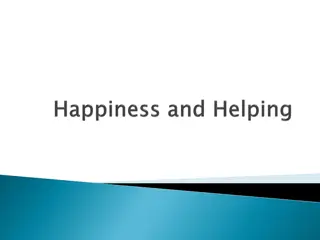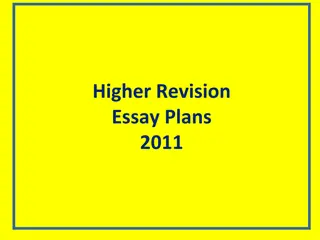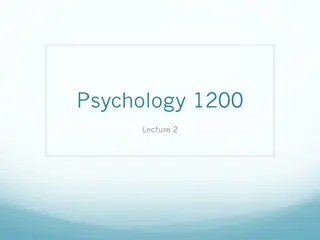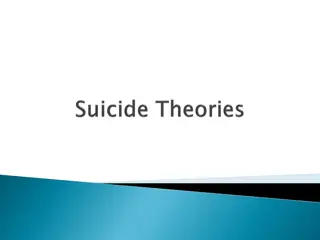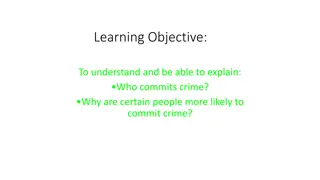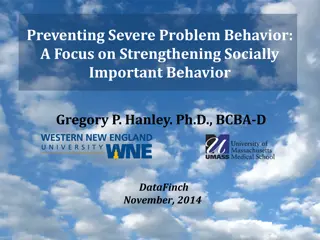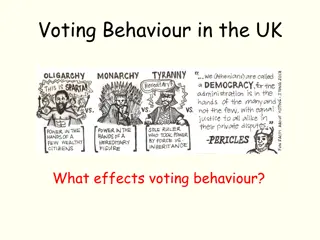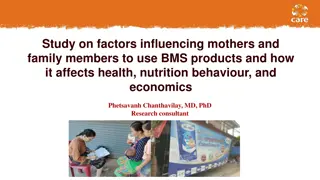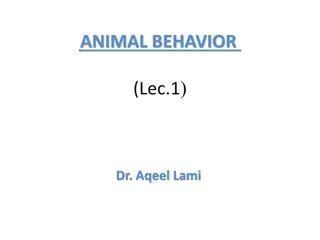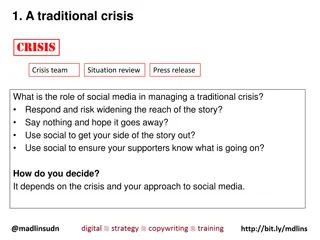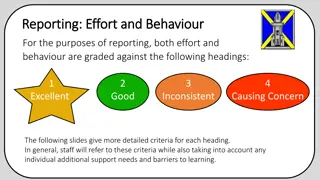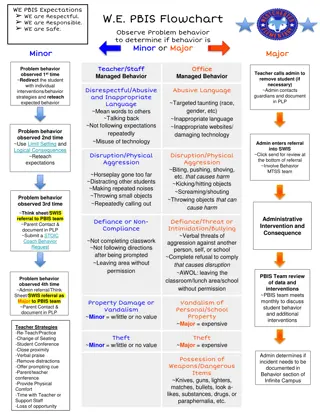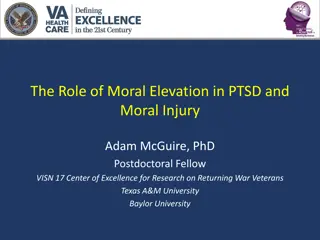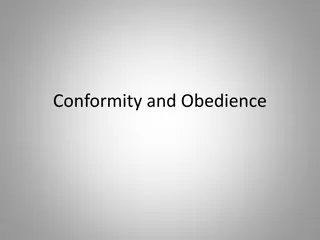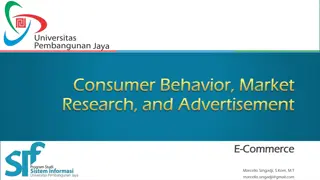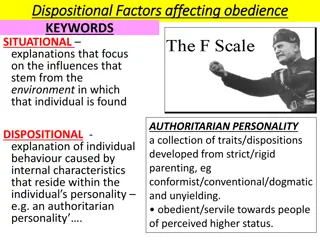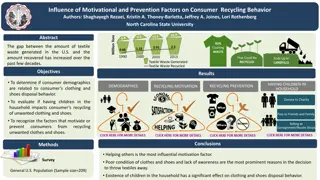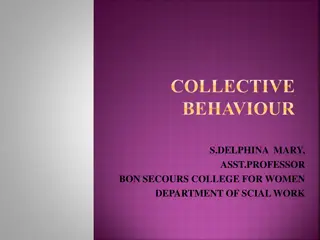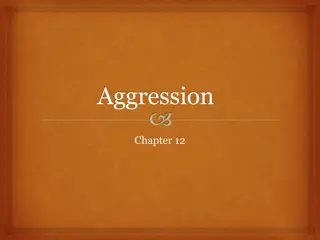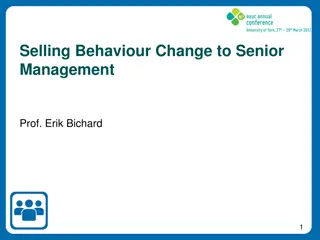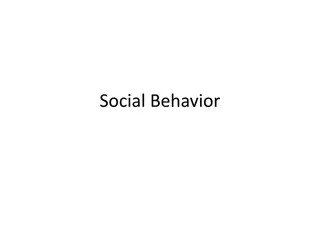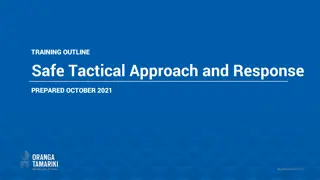Factors Influencing Prosocial Behavior in Social Situations
This selection of specialized psychological texts delves into the specific determinants of prosocial behavior, highlighting the impact of various factors on individuals' willingness to offer aid. It discusses how characteristics of the helper and person in need, along with situational elements like the presence of others and time constraints, play crucial roles in influencing prosocial actions. Insights from research, including the Kitty Genovese case study, shed light on the complex interplay between personal responsibility, bystander effect, and societal influences on helping behavior.
- Prosocial behavior
- Psychological texts
- Factors influencing behavior
- Social situations
- Bystander effect
Download Presentation

Please find below an Image/Link to download the presentation.
The content on the website is provided AS IS for your information and personal use only. It may not be sold, licensed, or shared on other websites without obtaining consent from the author. Download presentation by click this link. If you encounter any issues during the download, it is possible that the publisher has removed the file from their server.
E N D
Presentation Transcript
Specialized Psychological Texts Frist year Seconded semester Selected by Prof .Dr. NEAMA A.K.AHMED
SPECIFIC DETERMINANTS OF PROSOCIAL BEHAVIOR
We turn now to research on more specific factors helping. Social studies have shown that prosocial behavior is characteristics of characteristics of helper, and characteristics of the person in need. that influence psychological affected the the by situation, potential
Even the most dedicated altruist is less likely to offer aid in some situations than in others. Research has documented the importance of several situational factors, including the presence of other people, the nature of the physical environment, and the pressures of' limited time.
One of the shocking things about the Kitty Genovese murder is that so many people heard the young woman's screams and yet did not even call the police. Many social commentators interpreted this as a sign of widespread moral decay and alienation in society. Another hypothesis was offered by social psychologists Bibb Latane and John Dar- ley (1970). They proposed that the very presence of so many onlookers may have been a reason for the lack of helping.
Those who witnessed the murder may have assumed that others had already called the police, and so may have felt little personal responsibility to intervene. To test this idea that the number of witnesses affects helping, Darley and Latane (1968) designed the laboratory study described. College students who "emergency" were much more likely to respond if they were alone than if they thought others also knew about the situation. overheard an
The more people present, the less likely it was that any one individual actually offered help, and the longer the average delay before help was given. Darley and Latane called this the bystander effect. Many studies have replicated this finding in different settings (Latane & Nida, 1981). For example, Latane and conducted a field study at the Nu-Way Beverage Center in Suffern, New York Darley (1970)
The researchers staged a series of robberies. When the salesclerk went to the back of the store to check on something, two husky young men muttering, "They'll never miss this," walked off with a case of beer. The robberies were staged when either one or two customers were in the store. As expected, people who witnessed the crime alone were significantly more likely to report the theft to the clerk than people who were in the store with another customer.
Why does the presence of others sometimes inhibit helpfulness? The decision-making analysis of prosocial behavior explanations. One is the diffusion of responsibility created by the presence of other people. If only one person witnesses a victim in distress, then he or she is totally responsible for responding to the situation and will bear all the guilt or blame for nonintervention. When others are present, help can come from several people suggests several
The responsibility for helping and the possible costs of failing to offer aid are shared. Further, if a person knows that others are present but cannot actually talk to them or see their behavior, as in the Kitty Genovese case, the person may assume that others have already done something to help, such as calling the police. Experiments (Korte, 1971; Ross, 1971) have supported this idea that it is not the number of people present that is crucial, but the lessened feelings of personal responsibility that can result from being in a group.
A second explanation for the bystander effect concerns ambiguity in the interpretation of the situation. The decision-making analysis suggests that potential helpers are sometimes uncertain whether a particular situation is actually an emergency. The behavior of other bystanders can influence how we ourselves define a situation and react to it. If others ignore a situation or act as if nothing is happening, we too may assume that no emergency exists. The impact of bystanders on interpreting a situation was demonstrated by Latane and Darley (1970).
In this experiment, college men sat filling out a questionnaire. After a few minutes, smoke began to enter the room through a vent. Within four minutes, the smoke was so thick it was difficult to see and to breathe normally. When subjects were alone, they usually walked around the room to investigate the smoke, and 75 percent reported the smoke to the researcher within four minutes. In a condition where the real subject was in a room with two confederates who deliberately ignored the smoke, only 10 percent reported the smoke
This result is all the more dramatic because the smoke was very unpleasant. Apparently the calmness of the other people led subjects to define the situation as not dangerous. A third factor in the strength of the bystander effect is evaluation apprehension. If we know that other people are watching our behavior, we may try to do what we think others expect of us and to present ourselves in a favorable light (Baumeister, 1982). noticeable and
In some situations, such as the smoke-filled room, subjects may have feared they would look foolish or cowardly by showing concern about the smoke when others were apparently calm. The desire to avoid the cost of social disapproval inhibited action. In other situations, however, such as witnessing a person become seriously ill, we may assume that intervention is called for; here, the knowledge that others are aware of our actions may facilitate helping (Schwartz & Gott- lieb, 1980).
The willingness to help. Think for a moment about whether you are more likely to stop to help a stranded motorist on a pleasant, sunny day or a cold, rainy one? On a dark street in a poor section of town, or in a well-lighted affluent area? On a country lane, or in a big city? Much research has documented the impact of environmental conditions such as weather, city size, and noise level on helping. physical setting also influences
The effects of weather on helping were investigated in two Cunningham (1979). pedestrians were approached outdoors and asked to help the researcher by completing a questionnaire. People more likely to help when the day was sunny and when the temperature was comfortable (relatively warm in winter and relatively cool in summer) field In studies one by study, were significantly
In a second study conducted in a climate- controlled restaurant, Cunningham found that customers left more generous tips when the sun was shining. Other research suggests that people are more likely to help a stranded motorist in sunny rather than rainy weather (Ahmed, 1979) and during the day rather than at night (Skolnick, 1977). In short, weather does make a difference in helping, although psychologists are still debating the exact reasons for this effect.
A common stereotype is that city dwellers are unfriendly and unhelpful, whereas small town people are cooperative and helpful. Several studies indicate that when it comes to helping strangers in distress, city size does make a difference (see House &Wolf, 1978; Korte, 1981). In a recent study, Amato (1983) investigated helping in 55 Australian communities ranging from small villages to major cities. To ensure, a diverse sample of prosocial behaviors, five different types of helping were studied.
These included a student asking pedestrians to write down their favorite color as part of a school project, a pedestrian inadvertently dropping an envelope on the sidewalk, a request to donate money to the Multiple Sclerosis Society, overhearing a salesclerk give obviously wrong directions to someone, and witnessing a man with a bandaged leg fall to the ground and cry out in pain.
The results of this study are presented that four of the five helping measures, the percentage of people who helped was significantly greater in small towns than in larger cities. The one exception to this pattern was the lost envelope. It generally brought little helping, and seemed to get more in the largest cities. What should also be kept in mind, of course, is that these studies dealt only with help offered to strangers: There is no reason to believe that city dwellers are any less helpful than small-town people when it comes to helping friends and relatives.
Many explanations for the lesser helpfulness of city dwellers have been offered. These include the anonymity of urban life, the sensory overload experienced dwellers who are constantly bombarded by other people, and helplessness from dealing with unresponsive urban bureaucracies and governments. We don't yet know which explanation is most important. by city possible feelings of
Another environmental factor that can affect prosocial behavior is noise. Starting with the general idea that noise can reduce people's responsiveness to all events in the environment, several researchers have investigated whether noisy conditions reduce the likelihood of helping a stranger in distress (see Sherrod & Downs, 1974). In one lab study (Mathews & Canon, 1975), for example, it was found that noise decreased the likelihood that students would help a person who had dropped some papers on the floor
When only regular room noise was present, 72 percent of subjects helped, compared to only 37 percent when very loud noise was present. In a field study, the same investigators arranged to have a man wearing a cast on his arm drop some of the books he was carrying from his car. When only typical street noises were present, 80 percent of passersby helped, when a noisy lawn mower was going, only 15 percent helped. The researchers suggested that loud noise causes people to ignore others in their environment and motivates them to leave the situation quickly, thus creating less helpful bystanders.
Imagine, that you're walking across campus when a student stops you to ask for help with a fund drive for needy children. Are you more likely to help if you're out for a stroll or if you're late for a midterm exam? Both common sense and research evidence suggest that we are sometimes in too much of a hurry to help. A clear demonstration of this effect comes from an experiment by Darley and Batson (1973). As part of this study, individual students were asked to walk-to another building where they were to give a snort talk
Some were told to take their time, that the talk wouldn't begin for several minutes. Others were told to hurry because they were already late and the researcher was waiting. As the subject went from building to building, he encountered a shabbily dressed man slumped in a doorway, coughing and groaning. The question of interest was whether or not the subject would offer assistance.
A further twist to the study was that all participants were theological students. For some, the assigned topic for their talk was the Bible story of the Good Samaritan, about a person who came to the aid of a man who lay injured on the roadside, the victim of robbers. Other students were to talk about a topic not relevant to helping the sorts of jobs seminary students might pursue after graduation. The results of the study showed that time pressure had a strong impact on helping
In a postexperiment interview all students recalled seeing the victim. But only 10 percent of those in a hurry helped, compared to 63 percent of those who were not in a hurry. Perhaps surprisingly, the speech topic made no difference. Students about to talk on the Good Samaritan were no more likely to offer assistance than those preparing to talk on jobs. The researchers suggested that time pressure caused some students to overlook the needs of the victim. Another factor may have been a conflict about whom to help the experimenter or the victim.
The possibility that conflict rather than callousness was at work is supported by a second study (Batson et al. 1978) using a somewhat similar design. When students arrived for this study, they were sent individually to another building to interact with a computer. Some were told to hurry, and others were not. In addition, some were led to believe that their participation was of vital importance to the researcher, whereas others were told that their data were not essential. As the student went from building to building, he encountered a male undergraduate slumped on the stairs, coughing and groaning.
Would the subject help this victim? Results showed that students in a hurry were less likely to help (40 percent) than those with no time pressures (65 percent), but that this was primarily true for subjects who thought their research participation was essential. When subjects thought the researcher was not counting on them, those in a hurry were just about as likely to help (70 percent) as those not in a hurry (80 percent). These results are consistent with the cost-benefit model discussed earlier. Apparently subjects weighed the costs and benefits to both experimenter and victim before arriving at a final course of action.
Situational decrease the likelihood that people will act in a prosocial way. What these studies also show, however, is that some people offer aid even when situational forces discourage helping, and others fail to help even under the most favorable conditions. Individual differences do exist. In an effort to understand why some people help more than others, researchers have investigated both relatively enduring personality characteristics and more fleeting moods and psychological states. factors can greatly increase or


